Fiddle Leaf Fig Leaves Drooping: Causes + How to Revive It
Fiddle leaf figs have sensitive leaves that are susceptible to changes in the plant’s growing environment. Drooping bottom and top leaves are an early indicator that something isn’t right. It’s best to determine the problem in order to save the plant. So, what causes drooping in fiddle leaf figs?
Drooping fiddle fig leaves are a sign of underwatering or overwatering. Stress from high temperatures, poor light conditions, or potting shock can also cause wilting. Drain excess water from the pot and move the plant where there’s bright indirect light and water sparingly to revive the fiddle fig.
If the drooping persists and the leaves of your fiddle leaf fig turn yellow, remove the plant from its pot and examine the roots for root rot disease. I’ve explained below the causes and fixes to help you diagnose and treat to revive your plant.
Why are the leaves of my fiddle leaf fig drooping?
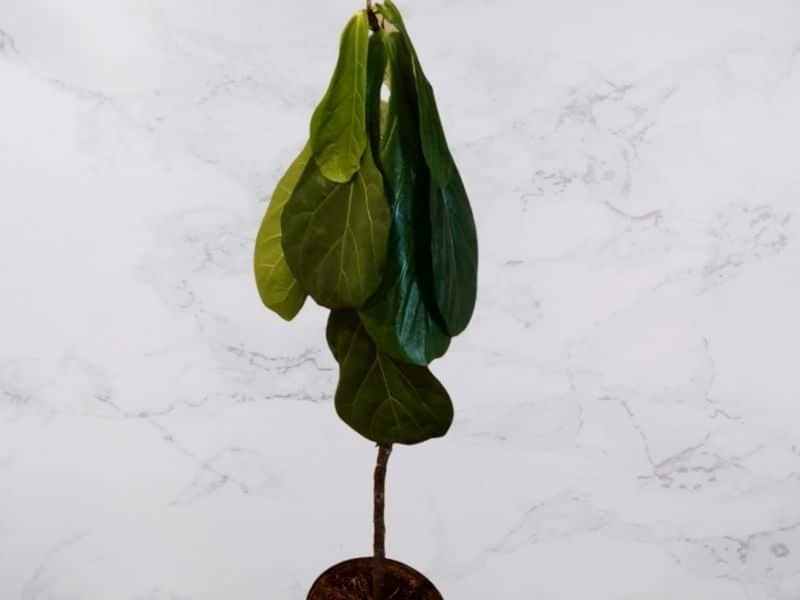
Fiddle leaf leaves droop for different reasons. It’s best to figure out what could be causing your plant’s leaves to slump so that you can find a suitable solution to the problem before it gets worse.
Here are some of the common causes of drooping leaves in fiddle leaf figs:
Underwatering
Underwatering your fiddle leaf fig can cause the plant’s leaves to droop. Inadequate watering results in dehydration, which can cause the plant’s foliage to lose its vibrant appeal and appear sickly.
You can tell if your plant receives enough water by constantly examining the soil underneath. Dry, brittle soil indicates that you have neglected your plant’s watering needs (which could be causing the foliage to droop).
Ensure that you regularly water your plant to prevent poor plant health, promote healthy foliage, and maintain a lush appearance.
Overwatering and root rot
Excessive watering can cause your fiddle fig leaves to droop and fall off. In addition, Overwatering drowns the roots and affects the plant’s ability to take in water, oxygen, and essential nutrients that the plant needs to grow.
Drooping and yellowing leaves in fiddle figs are an indication that your plant could be suffering from root rot disease caused by sogginess in the pot. It is the primary cause of root rot (which can eventually cause your plant to die if not treated on time.
Fiddle leaf figs prefer moist soils with adequate drainage. Water clogged soils are another sign that you could be using excess water during watering.
Keep in mind that sogginess can also lead to bacterial infections in fiddle figs. It’s best to adopt a suitable schedule that allows water to recede before you decide to add more to your plant.
Insufficient sunlight
Inadequate exposure to sunlight can be detrimental to your plant’s health. For example, sagging leaves can indicate that your plant does not receive adequate quantities of sunlight.
Fiddle leaf figs have sensitive leaves that suffer when the plant has limited access to sunlight. Other signs of inadequate sunlight exposure include yellowing foliage, stunted/reduced growth, and a tendency for the plant to tilt towards its light source.
High temperatures
Fiddle leaf figs have unique temperature requirements that can cause adverse effects on your plant’s health when overlooked. For example, high temperatures can cause your leaves to droop, develop black-brown spots, and dry if left unattended for long.
Increased temperatures cause excessive water loss during transpiration, making the leaves look saggy and unhealthy. The damage is more evident when growing your fiddle fig leaves outside where you have limited control over the external temperatures.
You can opt for different remedies to protect your plants from heat stress and extreme temperature changes during the warmer seasons.
Potting shock
Potting shock happens when you adjust your plant potting medium, pot size, etc. The action often causes your plant’s leaves to appear saggy and floppy as it adapts to its new environment.
Potting shock is common for most broad-leaved plants, including fiddle leaf figs. With proper care, you can expect your plant to recover and restore its foliage to pre-potting quality gradually.
You can aid in your plant’s recovery by ensuring sufficient access to light, water, and essential nutrients.
How to fix and revive a drooping fiddle leaf fig
Fixing a drooping fiddle leaf fig mainly depends on identifying and solving the reasons causing the leaves to lose their aesthetic appeal. You can adopt different approaches by tailoring your solutions to the plant’s needs.
Here’s how to fix and revive a drooping fiddle leaf fig:
1. Move the plant where there’s bright indirect light
Fiddle fig leaves require about 6 hours of bright indirect sunlight during the active growth phase. You can achieve this by moving it to an east-facing window that’s lightly covered with a curtain.
Ensuring adequate exposure to sunlight is essential in fixing drooping leaves and maintaining your plant’s health. You might start to notice changes in your plant’s foliage after a few days of continuous exposure to sunlight when the plant previously received inadequate sunlight.
If grown indoors, place your pot close to a window to give your fiddle leaf fig easy access to the morning and evening sun when the light intensity is moderate (and cannot harm the plant). A west or east-facing window will be great.
2. Let the soil dry out between waterings
If the drooping is caused by underwatering, water the plant adequately until the pot drips. Allow it to drip for some time so that the soil remains moist, then move it to its spot. Let the soil dry out between waterings to prevent drooping and wilting.
Maintaining a good watering schedule can help meet your plant’s water requirements. For example, fiddle leaf figs need watering about once a week with 10-day intervals depending on the season.
It’s best to adjust your watering schedule to accommodate seasonal changes in temperature and humidity. You should also avoid adding excess water to prevent overwatering.
A quality potting medium and drainage system can help control how much water the soil retains after each watering session. Regularly check the potting mix to determine if the plant needs watering before adding water.
Test whether your soil requires water by sticking your finger a few inches in the potting medium (finger test). Moist soil underneath indicates that your plant can survive a few more days without water. On the other hand, brittle, dry soil means that your plant urgently needs water.
You can also check the leaves for drooping, another indicator that your plant might need water, but this isn’t always a reliable sign.
3. Repot using a well-draining potting mix and larger pot
Fiddle leaf figs can reach a height of up to 6 feet. Therefore, you might have to occasionally shift your plant to larger pots to accommodate the size increase.
It’s crucial to use an ideal pot size/medium during repotting. Poor selection can leave your plant vulnerable to overwatering, saturated soils, etc. I’d advise you use a peat-perlite soil mix, preferably in a 2:1 ratio.
Suitable pot sizes should be about 3-4 inches wider in diameter and have a height increment of about 1-2 inches from the previous one. It’s also worth purchasing a pot with a drainage hole to allow for efficient drainage.
4. Feed the plant with 3-1-2 NPK fertilizer
Sometimes, your fiddle leaf fig will droop due to a lack of nutrients especially if the soil is overused. This kind of wilting and unhappiness, however, is not as vivid as that caused by underwatering.
Fertilizers are essential for maintaining the soil’s nutrient quality and perk up your plant. Fiddle leaf figs need a consistent application of fertilizer at least twice a year. The best time to spread the nutrient-enriching compound is during spring and autumn.
It’s best to use an organic, slow-release compound with a balanced NPK ratio. For example, 3-1-2 is a suitable NPK ratio for most fiddle leaf figs where a high nitrogen (N) content promotes healthy foliage growth, phosphorous (P) improves tissue development and potassium (K) allows for optimal plant growth and healthy roots.
Remember to follow the manufacturer’s guidelines when applying Fertilizer. Different products have unique spreading techniques, quantity specifications, etc.
5. Maintain temperature between 65℉ to 75℉ for the fig
Fiddle leaf figs are sensitive to temperature changes. Therefore, the species thrives under tropical conditions where temperatures range between 65℉ to 75℉.
The plant can tolerate temperature drops of up to 55 ℉ (Higher or lower temperatures can negatively affect the plant). Therefore, for fiddle leaf figs, it is best to insulate or move the plant indoors under room temperature conditions during winter and other cooler months to maintain active growth and prevent drooping/freezing.
You can occasionally mist your plant’s leaves during the summer months, where temperatures might rise above optimal conditions. Also, take notice of new growth to prevent sunburn and drooping, which may negatively affect your plant’s aesthetics and well-being.
Will the drooping leaves fall off?
Drooping bottom leaves in fiddle leaf figs may fall off especially if they’re mature and old. Mature leaves naturally droop, dry, and fall off as the plant grows. Therefore, the occurrence is purely natural, and it does not always imply that something is wrong with your plant.
However, suppose your plant’s foliage is pointing down due to poor health or negligence, you can correct the condition (and prevent the plant from losing essential green cover) by fulfilling your plant’s needs as soon as you notice the change in the leaves’ appearance.
READ NEXT: HOW TO TREAT EDEMA (RED SPOTS) ON FIDDLE LEAF FIGS


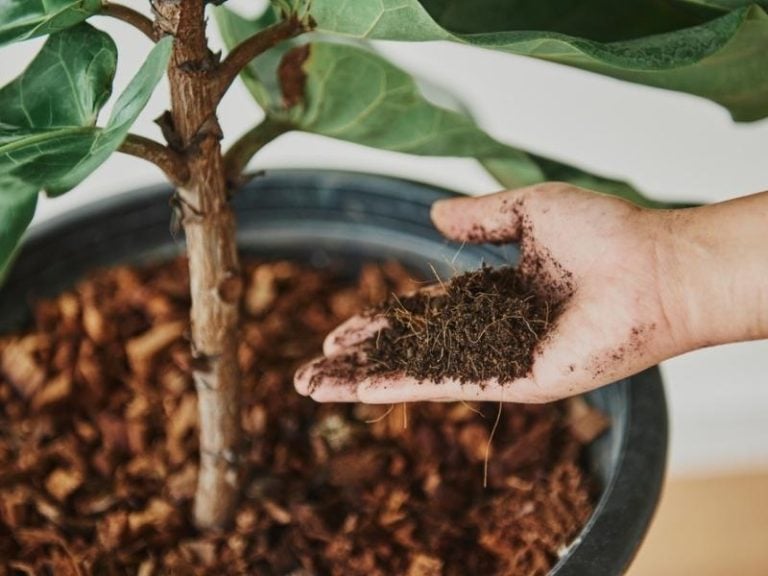
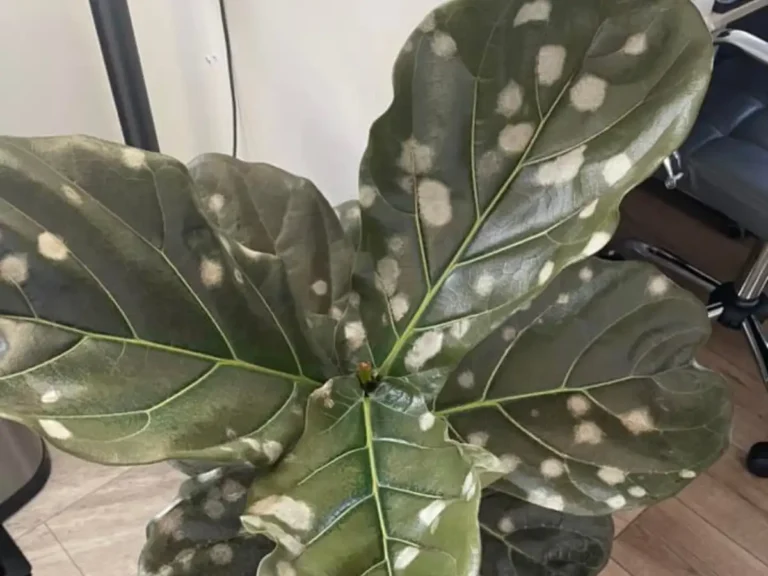
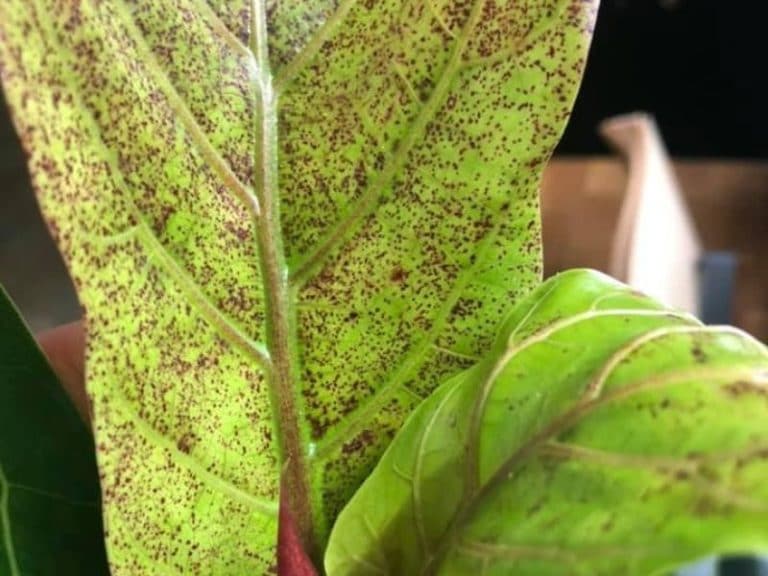
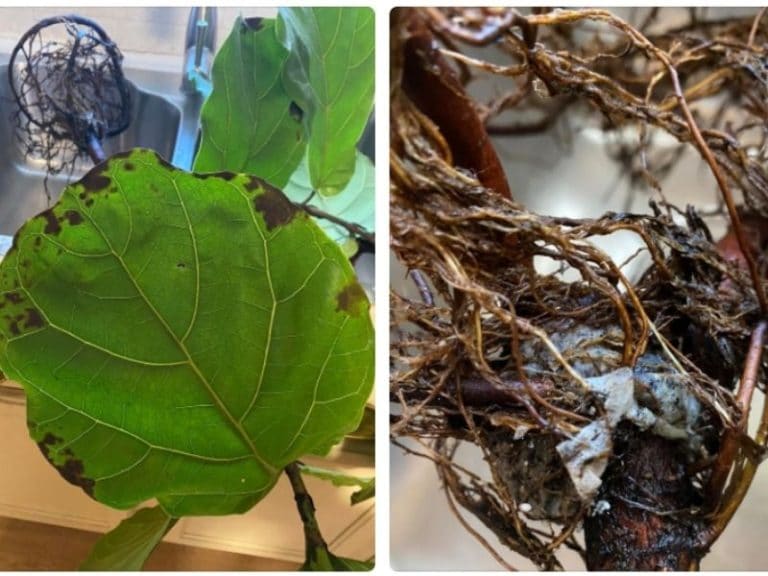

I have three leaves at the top and all of the leaves are drooping for 10 days.
What do you recommend.
Soil is moist and water every 7-10 days.